- Joined
- Oct 9, 2007
- Messages
- 47,655 (7.43/day)
- Location
- Dublin, Ireland
| System Name | RBMK-1000 |
|---|---|
| Processor | AMD Ryzen 7 5700G |
| Motherboard | Gigabyte B550 AORUS Elite V2 |
| Cooling | DeepCool Gammax L240 V2 |
| Memory | 2x 16GB DDR4-3200 |
| Video Card(s) | Galax RTX 4070 Ti EX |
| Storage | Samsung 990 1TB |
| Display(s) | BenQ 1440p 60 Hz 27-inch |
| Case | Corsair Carbide 100R |
| Audio Device(s) | ASUS SupremeFX S1220A |
| Power Supply | Cooler Master MWE Gold 650W |
| Mouse | ASUS ROG Strix Impact |
| Keyboard | Gamdias Hermes E2 |
| Software | Windows 11 Pro |
AMD today launched its Ryzen AI 300 series mobile processors, codenamed "Strix Point." These chips implement a combination of the AMD "Zen 5" microarchitecture for the CPU cores, the XDNA 2 architecture for its powerful new NPU, and the RDNA 3+ graphics architecture for its 33% faster iGPU. The new "Zen 5" microarchitecture provides a 16% generational IPC uplift over "Zen 4" on the backs of several front-end enhancements, wider execution pipelines, more intra core bandwidth, and a revamped FPU that doubles performance of AI and AVX-512 workloads. AMD didn't go in-depth with the microarchitecture, but the broad points of "Zen 5" are detailed in our article for the Ryzen 9000 "Granite Ridge" desktop processors. Not only is AMD using these faster "Zen 5" CPU cores, but also increased the CPU core count by 50%, for a maximum of 12-core/24-thread.
The "Strix Point" monolithic silicon is built on the 4 nm foundry node, and packs a CPU core complex (CCX) with 12 CPU cores, four of these are "Zen 5," which can achieve the highest possible boost frequencies, the other eight are "Zen 5c" cores that feature an identical IPC and the full ISA, including support for SMT; but don't boost as high as the "Zen 5" cores. AMD is claiming a productivity performance increase ranging between 4% and 73% for its top model based in the series, when compared to Intel's Core Ultra 9 185H "Meteor Lake" processor. The iGPU sees its compute unit (CU) count go all the way up to 16 from 12 in the previous generation, and this yields a claimed 33% increase in iGPU gaming performance compared to the integrated Arc graphics of the Core Ultra 9 185H. Lastly, the XDNA 2 NPU sees more that triple the AI inference performance to 50 AI TOPS, compared to the 16 TOPS of the Ryzen 8040 "Hawk Point" processor, and 12 TOPS of Core Ultra "Meteor Lake." This makes the processor meet Microsoft's Copilot+ AI PC requirements.



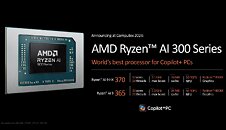
With this generation, AMD has revamped the processor naming scheme. Ryzen AI is the main brand, followed by a brand level (5, 7, 9, and form-factor U, H, HX); the generation (in this case, 3rd gen NPU-equipped Ryzen AI); and model number. Today, AMD is launching two processor models, the Ryzen AI 9 HX 370, and the Ryzen AI 9 365.


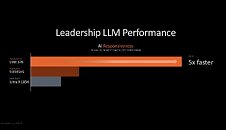

The HX 370 maxes out the silicon, featuring its full 12-core/24-thread CPU, its full 16 CU iGPU, and its XDNA 2 NPU with 50 TOPS on tap. The CPU cores boost up to 5.10 GHz, with a base frequency of 2.00 GHz. The chip's TDP is 28 W, but configurable between 15 W and 54 W by the OEM. The maxed out iGPU is branded the Radeon 890M Graphics, and comes with a maximum engine boost frequency of 2.90 GHz. The next processor model in the series if the Ryzen AI 9 365. This chip is configured with a 10-core/20-thread CPU with 2.00 GHz base- and 5.00 GHz boost frequencies; the Radeon 880M iGPU with 12 CU running at 2.90 GHz engine boost; and the same 50 AI TOPS NPU. It also has the same TDP numbers as the HX 370.
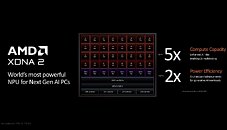
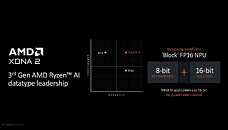


The new XDNA 2 NPU not only offers an over 3-fold increase in AI inferencing performance over the previous generation, but also support for the new Block FP16 datatype, which offers the performance of 8-bit with the precision of 16-bit. Since most AI applications use 16-bit, no quantization is needed.
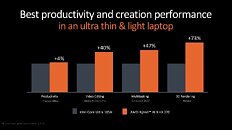
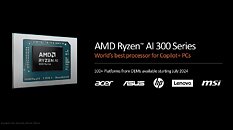
Notebooks powered by the Ryzen AI 300 series are announcing at Computex.
View at TechPowerUp Main Site
The "Strix Point" monolithic silicon is built on the 4 nm foundry node, and packs a CPU core complex (CCX) with 12 CPU cores, four of these are "Zen 5," which can achieve the highest possible boost frequencies, the other eight are "Zen 5c" cores that feature an identical IPC and the full ISA, including support for SMT; but don't boost as high as the "Zen 5" cores. AMD is claiming a productivity performance increase ranging between 4% and 73% for its top model based in the series, when compared to Intel's Core Ultra 9 185H "Meteor Lake" processor. The iGPU sees its compute unit (CU) count go all the way up to 16 from 12 in the previous generation, and this yields a claimed 33% increase in iGPU gaming performance compared to the integrated Arc graphics of the Core Ultra 9 185H. Lastly, the XDNA 2 NPU sees more that triple the AI inference performance to 50 AI TOPS, compared to the 16 TOPS of the Ryzen 8040 "Hawk Point" processor, and 12 TOPS of Core Ultra "Meteor Lake." This makes the processor meet Microsoft's Copilot+ AI PC requirements.




With this generation, AMD has revamped the processor naming scheme. Ryzen AI is the main brand, followed by a brand level (5, 7, 9, and form-factor U, H, HX); the generation (in this case, 3rd gen NPU-equipped Ryzen AI); and model number. Today, AMD is launching two processor models, the Ryzen AI 9 HX 370, and the Ryzen AI 9 365.




The HX 370 maxes out the silicon, featuring its full 12-core/24-thread CPU, its full 16 CU iGPU, and its XDNA 2 NPU with 50 TOPS on tap. The CPU cores boost up to 5.10 GHz, with a base frequency of 2.00 GHz. The chip's TDP is 28 W, but configurable between 15 W and 54 W by the OEM. The maxed out iGPU is branded the Radeon 890M Graphics, and comes with a maximum engine boost frequency of 2.90 GHz. The next processor model in the series if the Ryzen AI 9 365. This chip is configured with a 10-core/20-thread CPU with 2.00 GHz base- and 5.00 GHz boost frequencies; the Radeon 880M iGPU with 12 CU running at 2.90 GHz engine boost; and the same 50 AI TOPS NPU. It also has the same TDP numbers as the HX 370.




The new XDNA 2 NPU not only offers an over 3-fold increase in AI inferencing performance over the previous generation, but also support for the new Block FP16 datatype, which offers the performance of 8-bit with the precision of 16-bit. Since most AI applications use 16-bit, no quantization is needed.


Notebooks powered by the Ryzen AI 300 series are announcing at Computex.
View at TechPowerUp Main Site





